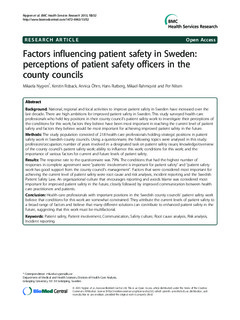| dc.contributor.author | Nygren, Mikaela | |
| dc.contributor.author | Roback, Kerstin | |
| dc.contributor.author | Öhrn, Annica | |
| dc.contributor.author | Rutberg, Hans | |
| dc.contributor.author | Rahmqvist, Mikael | |
| dc.contributor.author | Nilsen, Per | |
| dc.date.accessioned | 2017-06-07T12:42:26Z | |
| dc.date.available | 2017-06-07T12:42:26Z | |
| dc.date.issued | 2013 | |
| dc.identifier.citation | Nygren, M., Roback, K., Öhrn, A., Rutberg, H., Rahmqvist, M. & Nilsen, P. (2013) Factors influencing patient safety in Sweden: perceptions of patient safety officers in the county councils. BMC Health Services Research, 13(1), s. 52. | |
| dc.identifier.issn | 1472-6963 | |
| dc.identifier.uri | http://hdl.handle.net/11250/2445315 | |
| dc.description | Artikkelen beskriver en studie hvor hensikten var å undersøke helsepersonell sine oppfatninger knyttet til pasientsikkerhetsarbeid, faktorer de mener har vært viktigst for å nå dagens nivå på pasientsikkerheten, samt faktorer de mener vil være mest viktig for å oppnå forbedret pasientsikkerhet i fremtiden. | |
| dc.description.abstract | Background: national, regional and local activities to improve patient safety in Sweden have increased over the last decade. There are high ambitions for improved patient safety in Sweden. This study surveyed health care professionals who held key positions in their county council’s patient safety work to investigate their perceptions of the conditions for this work, factors they believe have been most important in reaching the current level of patient safety and factors they believe would be most important for achieving improved patient safety in the future. Methods: the study population consisted of 218 health care professionals holding strategic positions in patient safety work in Swedish county councils. Using a questionnaire, the following topics were analysed in this study: profession/occupation; number of years involved in a designated task on patient safety issues; knowledge/overview of the county council’s patient safety work; ability to influence this work; conditions for this work; and the importance of various factors for current and future levels of patient safety. Results: the response rate to the questionnaire was 79%. The conditions that had the highest number of responses in complete agreement were “patients’ involvement is important for patient safety” and “patient safety work has good support from the county council’s management”. Factors that were considered most important for achieving the current level of patient safety were root cause and risk analyses, incident reporting and the Swedish Patient Safety Law. An organizational culture that encourages reporting and avoids blame was considered most important for improved patient safety in the future, closely followed by improved communication between health care practitioners and patients. Conclusion: health care professionals with important positions in the Swedish county councils’ patient safety work believe that conditions for this work are somewhat constrained. They attribute the current levels of patient safety to a broad range of factors and believe that many different solutions can contribute to enhanced patient safety in the future, suggesting that this work must be multifactorial. | |
| dc.language.iso | eng | |
| dc.rights | Navngivelse 4.0 Internasjonal | |
| dc.rights.uri | http://creativecommons.org/licenses/by/4.0/deed.no | |
| dc.subject | pasientsikkerhet | |
| dc.subject | kvalitetssikring | |
| dc.subject | sikkerhet | |
| dc.subject | helsevesen | |
| dc.subject | pasienter | |
| dc.subject | helsetjenester | |
| dc.subject | uønskede hendelser | |
| dc.subject | barrierer | |
| dc.subject | meldekultur | |
| dc.subject | rapporteringskultur | |
| dc.subject | sikkerhetskultur | |
| dc.subject | pasientsikkerhetskultur | |
| dc.subject | pasientinvolvering | |
| dc.subject | brukerinvolvering | |
| dc.subject | pasientmedvirkning | |
| dc.subject | brukermedvirkning | |
| dc.subject | ROS-analyse | |
| dc.subject | risiko- og sårbarhetsanalyse | |
| dc.subject | spørreundersøkelse | |
| dc.subject | survey | |
| dc.subject | kommunikasjon | |
| dc.subject | Sverige | |
| dc.title | Factors influencing patient safety in Sweden: perceptions of patient safety officers in the county councils | |
| dc.type | Journal article | |
| dc.rights.holder | Nygren, Mikaela | |
| dc.source.volume | 13 | |
| dc.source.journal | BMC Health Services Research | |
| dc.source.issue | 1 | |
| dc.identifier.doi | 10.1186/1472-6963-13-52 | |

